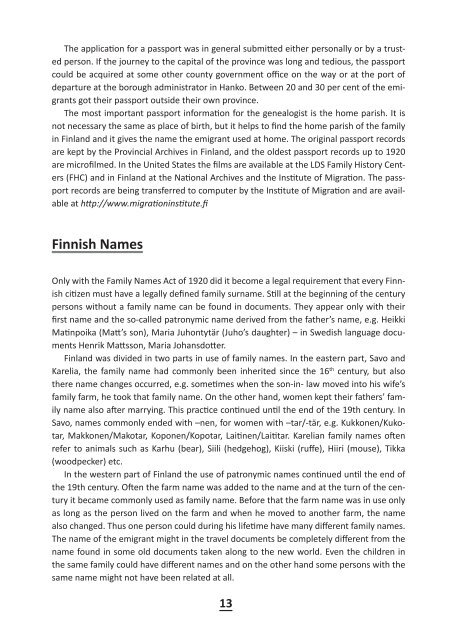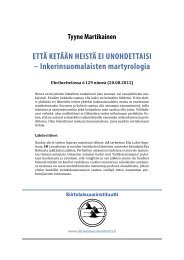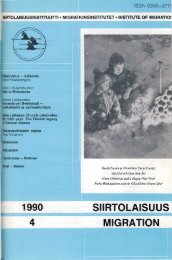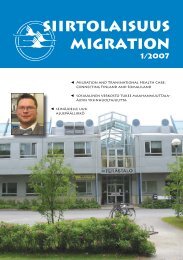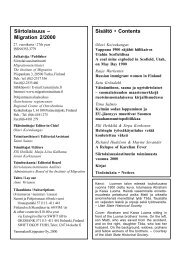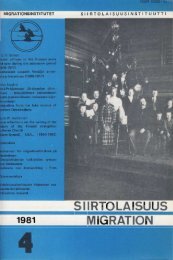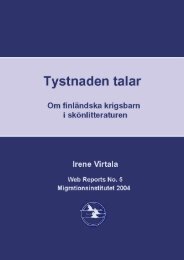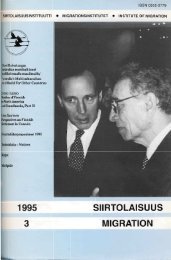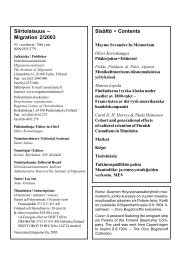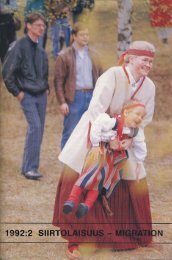How to trace your roots in Finland - Siirtolaisuusinstituutti
How to trace your roots in Finland - Siirtolaisuusinstituutti
How to trace your roots in Finland - Siirtolaisuusinstituutti
You also want an ePaper? Increase the reach of your titles
YUMPU automatically turns print PDFs into web optimized ePapers that Google loves.
The application for a passport was <strong>in</strong> general submitted either personally or by a trusted<br />
person. If the journey <strong>to</strong> the capital of the prov<strong>in</strong>ce was long and tedious, the passport<br />
could be acquired at some other county government office on the way or at the port of<br />
departure at the borough adm<strong>in</strong>istra<strong>to</strong>r <strong>in</strong> Hanko. Between 20 and 30 per cent of the emigrants<br />
got their passport outside their own prov<strong>in</strong>ce.<br />
The most important passport <strong>in</strong>formation for the genealogist is the home parish. It is<br />
not necessary the same as place of birth, but it helps <strong>to</strong> f<strong>in</strong>d the home parish of the family<br />
<strong>in</strong> F<strong>in</strong>land and it gives the name the emigrant used at home. The orig<strong>in</strong>al passport records<br />
are kept by the Prov<strong>in</strong>cial Archives <strong>in</strong> F<strong>in</strong>land, and the oldest passport records up <strong>to</strong> 1920<br />
are microfilmed. In the United States the films are available at the LDS Family His<strong>to</strong>ry Centers<br />
(FHC) and <strong>in</strong> F<strong>in</strong>land at the National Archives and the Institute of Migration. The passport<br />
records are be<strong>in</strong>g transferred <strong>to</strong> computer by the Institute of Migration and are available<br />
at http://www.migration<strong>in</strong>stitute.fi<br />
F<strong>in</strong>nish Names<br />
Only with the Family Names Act of 1920 did it become a legal requirement that every F<strong>in</strong>nish<br />
citizen must have a legally def<strong>in</strong>ed family surname. Still at the beg<strong>in</strong>n<strong>in</strong>g of the century<br />
persons without a family name can be found <strong>in</strong> documents. They appear only with their<br />
first name and the so-called patronymic name derived from the father’s name, e.g. Heikki<br />
Mat<strong>in</strong>poika (Matt’s son), Maria Juhontytär (Juho’s daughter) – <strong>in</strong> Swedish language documents<br />
Henrik Mattsson, Maria Johansdotter.<br />
F<strong>in</strong>land was divided <strong>in</strong> two parts <strong>in</strong> use of family names. In the eastern part, Savo and<br />
Karelia, the family name had commonly been <strong>in</strong>herited s<strong>in</strong>ce the 16 th century, but also<br />
there name changes occurred, e.g. sometimes when the son-<strong>in</strong>- law moved <strong>in</strong><strong>to</strong> his wife’s<br />
family farm, he <strong>to</strong>ok that family name. On the other hand, women kept their fathers’ family<br />
name also after marry<strong>in</strong>g. This practice cont<strong>in</strong>ued until the end of the 19th century. In<br />
Savo, names commonly ended with –nen, for women with –tar/-tär, e.g. Kukkonen/Kukotar,<br />
Makkonen/Makotar, Koponen/Kopotar, Lait<strong>in</strong>en/Laititar. Karelian family names often<br />
refer <strong>to</strong> animals such as Karhu (bear), Siili (hedgehog), Kiiski (ruffe), Hiiri (mouse), Tikka<br />
(woodpecker) etc.<br />
In the western part of F<strong>in</strong>land the use of patronymic names cont<strong>in</strong>ued until the end of<br />
the 19th century. Often the farm name was added <strong>to</strong> the name and at the turn of the century<br />
it became commonly used as family name. Before that the farm name was <strong>in</strong> use only<br />
as long as the person lived on the farm and when he moved <strong>to</strong> another farm, the name<br />
also changed. Thus one person could dur<strong>in</strong>g his lifetime have many different family names.<br />
The name of the emigrant might <strong>in</strong> the travel documents be completely different from the<br />
name found <strong>in</strong> some old documents taken along <strong>to</strong> the new world. Even the children <strong>in</strong><br />
the same family could have different names and on the other hand some persons with the<br />
same name might not have been related at all.<br />
13


